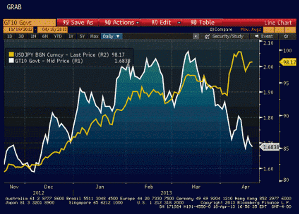This currency pair has failed to break the century mark in three previous attempts, and Kathy Lien of BKForex.com, outlines three factors that will need to change before a decisive break can finally happen.
With USD/JPY trading above 99 this morning, many forex traders are wondering whether it is finally time for the currency pair break 100. The past few weeks have been frustrating for anyone with short Japanese yen positions as USD/JPY struggled to rally. Since the BoJ’s decision to ease, USD/JPY climbed to 99.95, a few pips shy of 100—the key resistance level in the currency. We, along with many experts, agree that it is only a matter time before USD/JPY breaks 100 but will the second time be the charm? There’s no question that there are a ton of stops around 100, and in order for the currency pair to firmly break above this level, the three factors holding back the rally in recent weeks need to change:
#1 – US Bond Yields Need to Recover
Since November, USD/JPY enjoyed a nice steady rally that was supported by Shinzo Abe’s promise of aggressive monetary easing AND rising US bond yields. During this time, stronger US economic data and talk of tapering asset purchases boosted the dollar and Treasury yields. Now, the Japanese have delivered on easing, but US yields have plunged and as a result, one side of the equation was breaking down, capping the rally in USD/JPY. The turn in US yields began in March, but the selling accelerated after a series of US economic disappointments led investors to question the Federal Reserve’s ability to reduce stimulus by varying asset purchases. Even Fed officials are divided on what to make of recent reports. Some policymakers feel that the data is worrisome while others think the pullback is temporary. Either way, in order for USD/JPY to recover, we need US yields to stop falling and start rising.
#2 – Further Gains in the Nikkei
There has also been a very strong correlation between USD/JPY and the Nikkei over the past year as the weakness of the yen boosts the outlook for Japanese corporations. Aside from the prospect of more liquidity and a weaker currency, the Nikkei also followed US stocks higher. However over the last two weeks, the S&P 500 halted its record-breaking rally and global equity markets responded with their own losses. Given the strong correlation between USD/JPY and the Nikkei, it was no surprise then to see USD/JPY also dropping lower. Overnight, the Nikkei rebounded and US stock futures are pointing to a higher open and if risk appetite continues to improve, it could be one factor that supports a break above 100.
#3 – Japanese Investors Need to Buy Foreign Bonds
Yet despite the Bank of Japan’s aggressive easing, we have not seen any evidence of Japanese investors selling yen and buying foreign bonds. Every week the Ministry of Finance releases a report on Japanese purchases of foreign bonds and since the BoJ eased on April 4, the Japanese have been net sellers of foreign bonds. Two weeks ago they sold 1 trillion yen worth of foreign bonds and this week they sold 331 billion. When the BoJ eased, there was widespread belief that the Japanese would go global and dump domestic bonds in favor of buying foreign bonds and would leave their exposure unhedged because BoJ policy would keep the yen weak. The whole basis of most long USD/JPY trades is the belief that the Japanese would go global, and since that hasn’t happened, USD/JPY has been unable to rally. For a break of 100 in USD/JPY to be sustained, the weekly flow of funds data needs to start reporting net purchases of foreign bonds by Japanese investors.
While the Japanese have been slow to react, it should only be a matter of time before they start buying foreign bonds and when that occurs, the rally in USD/JPY will real.
By Kathy Lien, Co-Founder, BKForex.com





















